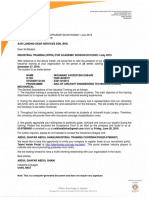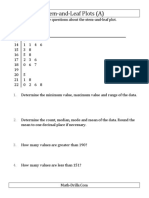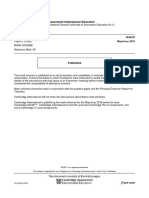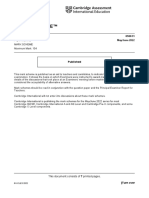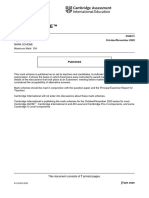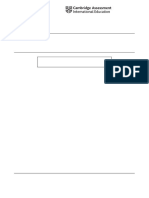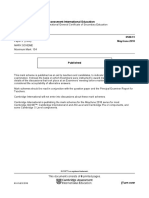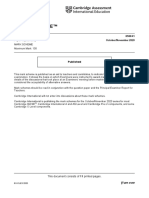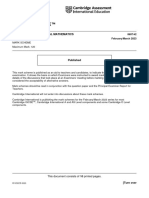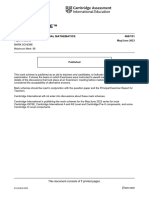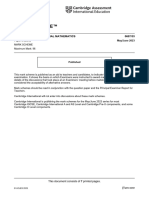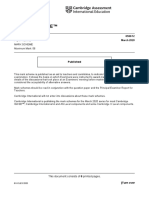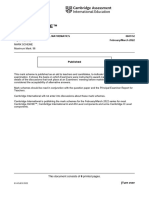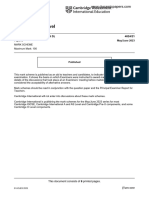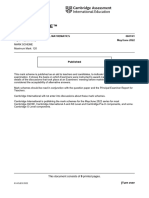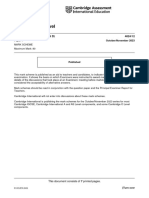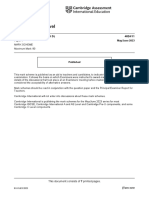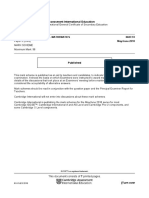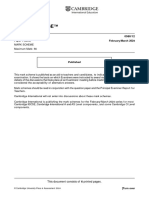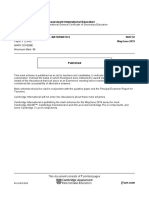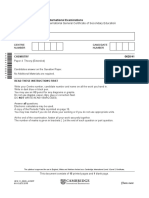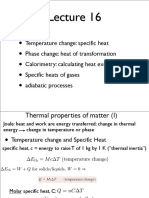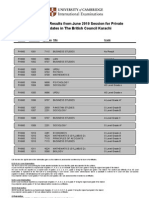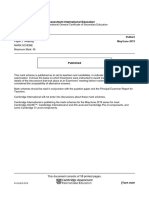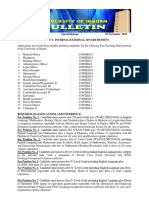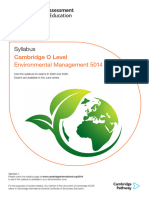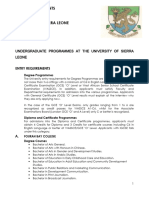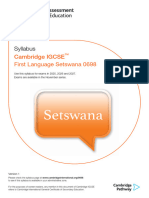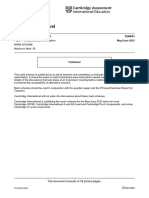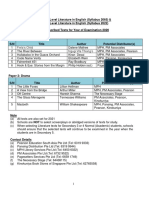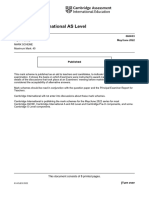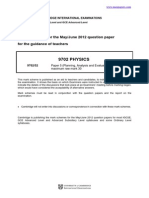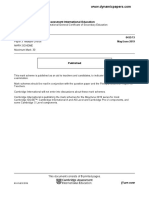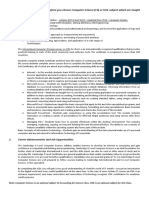Cambridge Assessment International Education
Cambridge Assessment International Education
Uploaded by
Yasser ZubaidiCopyright:
Available Formats
Cambridge Assessment International Education
Cambridge Assessment International Education
Uploaded by
Yasser ZubaidiOriginal Title
Copyright
Available Formats
Share this document
Did you find this document useful?
Is this content inappropriate?
Copyright:
Available Formats
Cambridge Assessment International Education
Cambridge Assessment International Education
Uploaded by
Yasser ZubaidiCopyright:
Available Formats
Cambridge Assessment International Education
Cambridge International General Certificate of Secondary Education
CAMBRIDGE INTERNATIONAL MATHEMATICS 0607/43
Paper 4 (Extended) October/November 2018
MARK SCHEME
Maximum Mark: 120
Published
This mark scheme is published as an aid to teachers and candidates, to indicate the requirements of the
examination. It shows the basis on which Examiners were instructed to award marks. It does not indicate the
details of the discussions that took place at an Examiners’ meeting before marking began, which would have
considered the acceptability of alternative answers.
Mark schemes should be read in conjunction with the question paper and the Principal Examiner Report for
Teachers.
Cambridge International will not enter into discussions about these mark schemes.
Cambridge International is publishing the mark schemes for the October/November 2018 series for most
Cambridge IGCSE™, Cambridge International A and AS Level components and some Cambridge O Level
components.
This document consists of 8 printed pages.
© UCLES 2018 [Turn over
0607/43 Cambridge IGCSE – Mark Scheme October/November
PUBLISHED 2018
Generic Marking Principles
These general marking principles must be applied by all examiners when marking candidate answers.
They should be applied alongside the specific content of the mark scheme or generic level descriptors
for a question. Each question paper and mark scheme will also comply with these marking principles.
GENERIC MARKING PRINCIPLE 1:
Marks must be awarded in line with:
• the specific content of the mark scheme or the generic level descriptors for the question
• the specific skills defined in the mark scheme or in the generic level descriptors for the question
• the standard of response required by a candidate as exemplified by the standardisation scripts.
GENERIC MARKING PRINCIPLE 2:
Marks awarded are always whole marks (not half marks, or other fractions).
GENERIC MARKING PRINCIPLE 3:
Marks must be awarded positively:
• marks are awarded for correct/valid answers, as defined in the mark scheme. However, credit
is given for valid answers which go beyond the scope of the syllabus and mark scheme,
referring to your Team Leader as appropriate
• marks are awarded when candidates clearly demonstrate what they know and can do
• marks are not deducted for errors
• marks are not deducted for omissions
• answers should only be judged on the quality of spelling, punctuation and grammar when these
features are specifically assessed by the question as indicated by the mark scheme. The
meaning, however, should be unambiguous.
GENERIC MARKING PRINCIPLE 4:
Rules must be applied consistently e.g. in situations where candidates have not followed
instructions or in the application of generic level descriptors.
GENERIC MARKING PRINCIPLE 5:
Marks should be awarded using the full range of marks defined in the mark scheme for the question
(however; the use of the full mark range may be limited according to the quality of the candidate
responses seen).
GENERIC MARKING PRINCIPLE 6:
Marks awarded are based solely on the requirements as defined in the mark scheme. Marks should
not be awarded with grade thresholds or grade descriptors in mind.
© UCLES 2018 Page 2 of 8
0607/43 Cambridge IGCSE – Mark Scheme October/November
PUBLISHED 2018
MARK SCHEME NOTES
The following notes are intended to aid interpretation of mark schemes in general, but individual mark schemes
may include marks awarded for specific reasons outside the scope of these notes.
Types of mark
M Method marks, awarded for a valid method applied to the problem.
A Accuracy mark, awarded for a correct answer or intermediate step correctly obtained. For accuracy
marks to be given, the associated Method mark must be earned or implied.
B Mark for a correct result or statement independent of Method marks.
When a part of a question has two or more ‘method’ steps, the M marks are in principle independent unless the
scheme specifically says otherwise; and similarly where there are several B marks allocated. The notation ‘dep’
is used to indicate that a particular M or B mark is dependent on an earlier mark in the scheme.
Abbreviations
awrt answers which round to
cao correct answer only
dep dependent
FT follow through after error
isw ignore subsequent working
nfww not from wrong working
oe or equivalent
rot rounded or truncated
SC Special Case
soi seen or implied
© UCLES 2018 Page 3 of 8
0607/43 Cambridge IGCSE – Mark Scheme October/November
PUBLISHED 2018
Question Answer Marks Partial Marks
1(a)(i) 38 2 190
cao M1 for implied by correct
83 225 + 190
unsimplified fraction
1(a)(ii) 45 : 38 final answer 2 M1 for 225 : 190 oe
If 0 scored SC1 for 38 : 45 final
answer
1(b) 18 2 M1 for 15 ÷ 5 soi by [1 part =] 3
1(c)(i) 45.5 or 45.45… 1
1(c)(ii) 3 2 20
M1 for × 15 oe
100
1(d) 375 nfww 3 4
M2 for 390 ÷ 1 + oe
100
or M1 for recognising 390 as 104%
2(a) Rotation 3 B1for each
90˚ clockwise oe
(5, 1)
2(b) Correct reflection 1
(– 1, 1), (– 4, 1), (– 4, 3)
2(c) Correct translation 2 5 k
(6, 7), (9, 7), (9, 9) B1 for translation or
k 6
2(d) Correct stretch 2 B1 for stretch factor 3 displaced
(1, 3), (4, 3), (4, 9) vertically
or stretch with x-axis invariant but
other factor.
3(a)(i) 1 1
3
3(a)(ii) 4 1
−2
3(a)(iii) 4.47 or 4.472… 2 FT their (ii)
M1 for ( their 4 ) + (their − 2)2
2
3(b)(i) 2 2 2 k
B1 for or
5 k 5
2
If 0 scored, SC1 for
5
3(b)(ii) ( 6, 17 ) 2 B1 for (6, k) or (k, 17)
© UCLES 2018 Page 4 of 8
0607/43 Cambridge IGCSE – Mark Scheme October/November
PUBLISHED 2018
Question Answer Marks Partial Marks
4(a)(i) Correct sketch 3 B2 for correct shaped branches but
branches joined
4
or B1 for one branch correct shape
2 (even if branches connected)
0
3 -2 -1 0 1 2 3
-2
-4
4(a)(ii) (0.707 or 0.7071… , 1.41 or 1.414…) 2 B1 for (0.707 or 0.7071… , k)
or for(k , 1.41 or 1.414…)
4(a)(iii) f(x) ⩾ 1.41 or 1.414…. 1 FT their (ii)
4(a)(iv) x=0 2 B1 for each
y = x oe
4(b)(i)(a) Correct sketches 2 B1 for increasing exponential graph
with negative y-intercept.
4
0
2 -1 0 1 2 3
-2
4(b)(i)(b) 2 B1 for correct shape all to right of
y-axis and x-intercept not too far
from 1.
4(b)(ii) 0.556 or 0.5559… < x < 2.4[0] or 2.401… 2 B1 for both correct values seen
5(a) 7.5 2 B1 for each
9
5(b) Positive 1
5(c) [y = ]0.681 (or 0.6812…)x 2 B1 for 0.681 (or 0.6812…)x + k
+ 1.98 (or 1.982…) or for kx + 1.98 (or 1.982…)
or for 0.68x + 2[.0]
6(a) 96.9 or 96.90… 2 M1 for 0.5 × 11 × 23 × sin50 oe
6(b) 18[.0] or 18.02… 3 B2 for 325 or 324.7…
or M1 for
112 + 232 − 2 × 11× 23 × cos50 oe
© UCLES 2018 Page 5 of 8
0607/43 Cambridge IGCSE – Mark Scheme October/November
PUBLISHED 2018
Question Answer Marks Partial Marks
7(a) 23 500 3 B2 for 23 470 or 23 474. …
2
5
or M1 for 26 010 × 1 − oe
100
If 0 scored, SC1 for 9300 or 9320 or
9324
or for their seen answer rounded to the
nearest 100
7(b)(i) 25 000 cao nfww 2 2
2
M1 for 26 010 ÷ 1 +
100
7(b)(ii) 14 nfww 4 26010
M3 for n log(1.02) = log soi
20000
by 13 or 13.3 or 13.26 to 13.27
or for trial and improvement
reaching n = 13 and 14
26010
or M2for (1.02 ) =
n
oe
20000
or for trial and improvement at
least 3 times
or M1 for 26010 = 20000(1.02)n oe
8(a) Correct sketch 2 B1 for parabola vertex upwards but
6
incorrect intersections with axes
4
0
1 0 1 2 3 4 5
-2
-4
8(b) x = 2 oe 1
8(c)(i) – 0.236 or – 0.2361 to – 0.2360 2 B1 for each
4.24 or 4.236…
8(c)(ii) – 0.236 or – 0.2361 to – 0.2360 < x 1 FT their (b)(i)
< 4.24 or 4.236…
8(d) – 0.449 or – 0.4495 to – 0.4494 2 B1 for each
4.45 or 4.449… If 0 scored, B1 for y = –1 sketched
8(e) Correct line sketched, passing through 2 B1 for line with negative gradient or
(5, 0) with y-intercept reasonably close to 5
but not through (0, 6)
8(f) Region below curve and below line 1
shaded, continuing below x-axis
© UCLES 2018 Page 6 of 8
0607/43 Cambridge IGCSE – Mark Scheme October/November
PUBLISHED 2018
Question Answer Marks Partial Marks
9(a) 11 2 1 1
oe M1 for 1 − −
20 5 4
9(b)(i) 2 11 1 FT their (a)
and correctly placed
3 20
9(b)(ii) 8 3 2 1 11
oe M2 for × + their
15 3 4 20
2 1
or × 1 − oe
3 5
1 2 1
or 1 − − ×
3 3 5
2 1
or M1 for ×
3 4
2 11
or × their
3 20
1 2 1
or + ×
3 3 5
1 11
or +
4 20
9(b)(iii) 48 final answer 1 FT their (b)(ii)
10(a) 60.3 or 60.25 to 60.26 2 7
M1 for tan = oe
4
10(b) 54.5 or 54.46… 3 7
M2 for tan = oe
1 2 2
6 +8
2
or M1 for 62 + 82 or 32 + 42 oe
10(c) 8.6[0] or 8.602… 2 M1 for 7 2 + ( their 5)2 oe
10(d) 69.6 or 69.58 to 69.59 2 3
M1 for cos = oe
their PC
10(e) 6.49 or 6.493… 3 6sin(their(d))
M2 for oe
sin60
sin 60 sin(their (d))
or M1 for =
6 BX
11(a) 70, 80, 30 2 B1 for 2
11(b) 156.25 2 M1 for mid-values soi
© UCLES 2018 Page 7 of 8
0607/43 Cambridge IGCSE – Mark Scheme October/November
PUBLISHED 2018
Question Answer Marks Partial Marks
12(a) 4.75 3 B2 for 8x = 38 oe
or M1 for 2{(3x + 2) + (x + 1)} = 44
or (3x + 2) + (x + 1) = 22
12(b) 17 cao 3 B2 for 16 and 17 seen
or sketch showing 17
or ( y + 16)( y − 17) seen
−( −1) ± ( −1) 2 − 4(1)(−272)
or oe
2(1)
or B1 for 17 seen
or M1 for y(y – 1 ) = 272 or better
or appropriate sketch but not
indicating 17
12(c) 2.5 oe 3 M2 for vw = 5 and (v + 1)w = 7 oe
or M1 for one of these equations oe
12(d) 1.69 or 1.690… only cao 4 M3 for 6 p 2 − 6 p − 7[ = 0] oe
or M2 for
9 10
2 2 p + + 2 = 2 3 p + oe
2p 3p
9 10
or M1 for or soi
2p 3p
13(a) 4 1
13(b)(i) 1 – 3x oe 2 M1 for 3(1 – x) – 2
13(b)(ii) 5x 3 B2 for −3x 2 + 3x + 2 x − 2
or M1 for (3x − 2)(1 − x) + 3 x 2 + 2
13(c) 1 – x oe 1
13(d)(i) 4 2 M1 for 3x – 2 = 2
oe
3
13(d)(ii) ±1 , ± 7 nfww 3 M1 for x 2 − 4 = ±3 oe (implied by 1
and 7 )
A1 dep on M1 for two correct answers
If 0 scored, SC1 for ± 7 or for ±1
© UCLES 2018 Page 8 of 8
You might also like
- Cover LetterDocument1 pageCover LetterYasser ZubaidiNo ratings yet
- Regents Exams and Answers Geometry Revised EditionFrom EverandRegents Exams and Answers Geometry Revised EditionNo ratings yet
- Stem-And-Leaf Questions AllDocument20 pagesStem-And-Leaf Questions AllYasser Zubaidi0% (1)
- Cambridge Assessment International EducationDocument6 pagesCambridge Assessment International EducationnyiNo ratings yet
- 0580 w19 Ms 31 PDFDocument6 pages0580 w19 Ms 31 PDFНара ДжафароваNo ratings yet
- Cambridge Assessment International Education: Mathematics 0626/05 May/June 2018Document8 pagesCambridge Assessment International Education: Mathematics 0626/05 May/June 2018AFRAH ANEESNo ratings yet
- 0580 s18 Ms 32Document7 pages0580 s18 Ms 32Tavish AppadooNo ratings yet
- Cambridge Assessment International Education: Mathematics 0626/01 May/June 2018Document6 pagesCambridge Assessment International Education: Mathematics 0626/01 May/June 2018AFRAH ANEESNo ratings yet
- Cambridge IGCSE™: Mathematics 0580/31 May/June 2022Document7 pagesCambridge IGCSE™: Mathematics 0580/31 May/June 2022ivan micoNo ratings yet
- Cambridge IGCSE Maths 0580 31 Paper 3 Core Mark Scheme Nov 2020Document7 pagesCambridge IGCSE Maths 0580 31 Paper 3 Core Mark Scheme Nov 2020reemabousteitNo ratings yet
- Cambridge Assessment International EducationDocument8 pagesCambridge Assessment International EducationRia BaidNo ratings yet
- Cambridge IGCSE ™ (9-1) : Mathematics 0980/31 October/November 2022Document8 pagesCambridge IGCSE ™ (9-1) : Mathematics 0980/31 October/November 2022scepticsNo ratings yet
- 0580 s18 Ms 33-CIE-IGCSE-MathsDocument6 pages0580 s18 Ms 33-CIE-IGCSE-Mathsyunmi choiNo ratings yet
- Cambridge Assessment International Education: Mathematics 0580/42 March 2019Document8 pagesCambridge Assessment International Education: Mathematics 0580/42 March 2019Ainalnaem GhidariNo ratings yet
- March 2022 (v2) Ms - Paper 2 Caie Maths IgcseDocument8 pagesMarch 2022 (v2) Ms - Paper 2 Caie Maths IgcseShweta VyasNo ratings yet
- Cambridge Assessment International Education: Mathematics 0580/31 May/June 2018Document6 pagesCambridge Assessment International Education: Mathematics 0580/31 May/June 2018Ariyah SinghNo ratings yet
- Cambridge IGCSE™: Mathematics 0580/41 October/November 2020Document11 pagesCambridge IGCSE™: Mathematics 0580/41 October/November 2020Nathan MwansaNo ratings yet
- maths 2022 past paper mjDocument7 pagesmaths 2022 past paper mjSIAM PLAZ YTNo ratings yet
- Cambridge IGCSE™Document9 pagesCambridge IGCSE™xyz298559No ratings yet
- 0580 w18 Ms 43Document8 pages0580 w18 Ms 43Adides Gidson SimanjuntakNo ratings yet
- Cambridge IGCSE™: Mathematics 0580/43 May/June 2022Document11 pagesCambridge IGCSE™: Mathematics 0580/43 May/June 2022hildebrandokNo ratings yet
- Cambridge IGCSE™: Mathematics 0580/42 March 2021Document10 pagesCambridge IGCSE™: Mathematics 0580/42 March 2021Nyan Lin HsetNo ratings yet
- Cambridge IGCSE ™: Mathematics 0580/43Document9 pagesCambridge IGCSE ™: Mathematics 0580/43shabanaNo ratings yet
- Cambridge IGCSE ™Document10 pagesCambridge IGCSE ™grengtaNo ratings yet
- Cambridge IGCSE™: Mathematics 0580/43 May/June 2020Document8 pagesCambridge IGCSE™: Mathematics 0580/43 May/June 2020KarimNo ratings yet
- Cambridge IGCSE™Document7 pagesCambridge IGCSE™grengtaNo ratings yet
- November 2020 (v2) MS - Paper 4 CIE Maths IGCSEDocument9 pagesNovember 2020 (v2) MS - Paper 4 CIE Maths IGCSEKinisha KohliNo ratings yet
- Cambridge IGCSE™: Cambridge International Mathematics 0607/42 May/June 2020Document8 pagesCambridge IGCSE™: Cambridge International Mathematics 0607/42 May/June 2020Custard ಥಥNo ratings yet
- Cambridge IGCSE™Document9 pagesCambridge IGCSE™Sougo TokiwaNo ratings yet
- Cambridge IGCSE™Document7 pagesCambridge IGCSE™grengtaNo ratings yet
- Cambridge IGCSE™: Mathematics 0580/12 March 2020Document6 pagesCambridge IGCSE™: Mathematics 0580/12 March 2020Shayan NaveedNo ratings yet
- Cambridge IGCSE™: Cambridge International Mathematics 0607/22 October/November 2020Document5 pagesCambridge IGCSE™: Cambridge International Mathematics 0607/22 October/November 2020Lorraine Sabbagh100% (1)
- Cambridge IGCSE™Document8 pagesCambridge IGCSE™grengtaNo ratings yet
- June 2018 (v1) MS - Paper 4 CIE Maths IGCSEDocument8 pagesJune 2018 (v1) MS - Paper 4 CIE Maths IGCSEreddyhemanya20No ratings yet
- Cambridge IGCSE™: Cambridge International Mathematics 0607/32 February/March 2022Document6 pagesCambridge IGCSE™: Cambridge International Mathematics 0607/32 February/March 2022sri manjaNo ratings yet
- Cambridge IGCSE™: Additional Mathematics 0606/13 May/June 2022Document9 pagesCambridge IGCSE™: Additional Mathematics 0606/13 May/June 2022JeremiahNo ratings yet
- Cambridge Assessment International Education: Mathematics 0580/33 May/June 2019Document6 pagesCambridge Assessment International Education: Mathematics 0580/33 May/June 2019Prince YugNo ratings yet
- Q4 (3b)Document8 pagesQ4 (3b)Amyn WahidNo ratings yet
- Cambridge IGCSE™: Mathematics 0580/33 May/June 2022Document7 pagesCambridge IGCSE™: Mathematics 0580/33 May/June 2022wallacec1017No ratings yet
- June 2020 (v3) MS - Paper 4 CIE Maths IGCSEDocument8 pagesJune 2020 (v3) MS - Paper 4 CIE Maths IGCSEDIY TaskerNo ratings yet
- 0607 PaperDocument10 pages0607 PaperPoojaNo ratings yet
- November 2018 (v1) MS - Paper 4 CIE Maths IGCSEDocument8 pagesNovember 2018 (v1) MS - Paper 4 CIE Maths IGCSEAkramNo ratings yet
- Cambridge IGCSE™: Cambridge International Mathematics 0607/43 October/November 2021Document9 pagesCambridge IGCSE™: Cambridge International Mathematics 0607/43 October/November 2021Kimberly Anne B. FerranNo ratings yet
- Cambridge IGCSE™: Mathematics 0580/32 May/June 2020Document7 pagesCambridge IGCSE™: Mathematics 0580/32 May/June 2020ENVY千ᛊ乂No ratings yet
- This Is BookDocument9 pagesThis Is BookAdarsh DubeNo ratings yet
- Cambridge IGCSE ™Document7 pagesCambridge IGCSE ™grengtaNo ratings yet
- Cambridge IGCSE ™: Mathematics 0580/22 October/November 2022Document7 pagesCambridge IGCSE ™: Mathematics 0580/22 October/November 2022Rita SmairatNo ratings yet
- Cambridge O Level: Mathematics (Syllabus D) 4024/12Document7 pagesCambridge O Level: Mathematics (Syllabus D) 4024/12hurairah000000No ratings yet
- Cambridge O Level: Mathematics (Syllabus D) 4024/11Document7 pagesCambridge O Level: Mathematics (Syllabus D) 4024/11Aiza ZeeNo ratings yet
- Cambridge Assessment International EducationDocument7 pagesCambridge Assessment International EducationRia BaidNo ratings yet
- Cambridge IGCSE ™: Mathematics 0580/12Document6 pagesCambridge IGCSE ™: Mathematics 0580/12enzeyeeNo ratings yet
- Cambridge Assessment International EducationDocument7 pagesCambridge Assessment International EducationAserothNo ratings yet
- Cambridge IGCSE™: Cambridge International Mathematics 0607/42 March 2021Document9 pagesCambridge IGCSE™: Cambridge International Mathematics 0607/42 March 2021Custard ಥಥNo ratings yet
- Cambridge IGCSE™: Cambridge International Mathematics 0607/42 March 2021Document9 pagesCambridge IGCSE™: Cambridge International Mathematics 0607/42 March 2021Custard ಥಥNo ratings yet
- Cambridge IGCSE™: Mathematics 0580/22 February/March 2022Document8 pagesCambridge IGCSE™: Mathematics 0580/22 February/March 2022TrynosNo ratings yet
- Feb:March 22-2msDocument8 pagesFeb:March 22-2mscsg5r7q9t5No ratings yet
- 4024 s18 Ms 21Document8 pages4024 s18 Ms 21Wnc WestridgeNo ratings yet
- November 2020 (v1) MS - Paper 4 CIE Maths IGCSEDocument11 pagesNovember 2020 (v1) MS - Paper 4 CIE Maths IGCSEVictoria OlutimehinNo ratings yet
- Economic and Financial Modelling with EViews: A Guide for Students and ProfessionalsFrom EverandEconomic and Financial Modelling with EViews: A Guide for Students and ProfessionalsNo ratings yet
- Cambridge International General Certificate of Secondary EducationDocument16 pagesCambridge International General Certificate of Secondary EducationYasser ZubaidiNo ratings yet
- Lecture16 PDFDocument6 pagesLecture16 PDFYasser ZubaidiNo ratings yet
- s5 Removed PDFDocument14 pagess5 Removed PDFYasser ZubaidiNo ratings yet
- Acknowledgement Copy - ALGEBRA COMMODITIES PLT PDFDocument1 pageAcknowledgement Copy - ALGEBRA COMMODITIES PLT PDFYasser ZubaidiNo ratings yet
- Pakistan Exams Gce Result Mj10 Khi Pk660Document83 pagesPakistan Exams Gce Result Mj10 Khi Pk660Talha KhanNo ratings yet
- Call For Applications For Admission Into ODeL Undergraduate Programmes-1Document3 pagesCall For Applications For Admission Into ODeL Undergraduate Programmes-1KennedyNo ratings yet
- PROSPECTUS 2023/2024: Postal Address P. O. Box A 624 Swazi Plaza, Mbabane H101 Kingdom of EswatiniDocument11 pagesPROSPECTUS 2023/2024: Postal Address P. O. Box A 624 Swazi Plaza, Mbabane H101 Kingdom of EswatiniMsimisi Sukoluhle MtsetfwaNo ratings yet
- Cambridge International AS & A Level: May/June 2023Document11 pagesCambridge International AS & A Level: May/June 2023zainabwaqas2007No ratings yet
- 4024 w08 Ms 2Document9 pages4024 w08 Ms 2mstudy123456No ratings yet
- Cambridge International AS & A Level: Accounting 9706/42Document13 pagesCambridge International AS & A Level: Accounting 9706/42mianhuzaifaalitajNo ratings yet
- Cambridge Assessment International Education: Malay 0546/23 May/June 2019Document13 pagesCambridge Assessment International Education: Malay 0546/23 May/June 2019ezeeshah0512No ratings yet
- 0510 English As A Second Language: MARK SCHEME For The October/November 2013 SeriesDocument12 pages0510 English As A Second Language: MARK SCHEME For The October/November 2013 Seriesshadhin239No ratings yet
- 5090 s14 Ms 62 PDFDocument4 pages5090 s14 Ms 62 PDFJotaro kujoNo ratings yet
- Non-Teaching Staff Positions Advert Nov. 2023Document2 pagesNon-Teaching Staff Positions Advert Nov. 2023Isamah ChukwunaluNo ratings yet
- EnvironmentalDocument37 pagesEnvironmentalbq22z788ycNo ratings yet
- University of Sierra Leone Updated Entry RequirementsDocument16 pagesUniversity of Sierra Leone Updated Entry Requirementsalhajisarpongkamara035No ratings yet
- 2025 2027 SyllabusDocument24 pages2025 2027 SyllabuskumulelameNo ratings yet
- Cambridge Assessment International Education: First Language English 0500/32 March 2019Document12 pagesCambridge Assessment International Education: First Language English 0500/32 March 2019janmarkowski23No ratings yet
- Cambridge International AS & A Level: Accounting 9706/12 May/June 2020Document3 pagesCambridge International AS & A Level: Accounting 9706/12 May/June 2020redwanNo ratings yet
- Terms and Condition ManualDocument85 pagesTerms and Condition Manualabernie12091No ratings yet
- Cambridge IGCSE™: Mathematics 0580/23Document8 pagesCambridge IGCSE™: Mathematics 0580/23Grand Meme VinesNo ratings yet
- Cambridge O Level: Second Language Urdu 3248/01Document13 pagesCambridge O Level: Second Language Urdu 3248/01Haleema GulNo ratings yet
- Upper Secondary Lit EnglishDocument2 pagesUpper Secondary Lit EnglishAthanasioNo ratings yet
- Cambridge International AS Level: Portuguese Language 8684/03 May/June 2022Document3 pagesCambridge International AS Level: Portuguese Language 8684/03 May/June 2022poifokampuraNo ratings yet
- 9702 PHYSICS: MARK SCHEME For The May/June 2012 Question Paper For The Guidance of TeachersDocument4 pages9702 PHYSICS: MARK SCHEME For The May/June 2012 Question Paper For The Guidance of Teacherswnwd97No ratings yet
- Cambridge Assessment International Education: Economics 0455/13 May/June 2019Document3 pagesCambridge Assessment International Education: Economics 0455/13 May/June 2019sana hazemNo ratings yet
- 0580 s19 Ms 42 PDFDocument9 pages0580 s19 Ms 42 PDFKatrine Jaya AndrewNo ratings yet
- Paper 2 Nov 2001 PhysicsDocument16 pagesPaper 2 Nov 2001 Physicssolarixe100% (2)
- 8001 General Paper: MARK SCHEME For The October/November 2006 Question PaperDocument10 pages8001 General Paper: MARK SCHEME For The October/November 2006 Question Papercody martinNo ratings yet
- Icdl CS2210Document1 pageIcdl CS2210lapsa22No ratings yet
- Cambridge International AS & A Level: Further Mathematics 9231/23Document15 pagesCambridge International AS & A Level: Further Mathematics 9231/23Saad HasanNo ratings yet
- Cambridge IGCSE ™: Chemistry 0620/12Document3 pagesCambridge IGCSE ™: Chemistry 0620/12m.abdullahkhan13No ratings yet
- MIB Bulletin Dec 2007 Jan 2008 - Namibian GovernmentDocument20 pagesMIB Bulletin Dec 2007 Jan 2008 - Namibian GovernmentMilton LouwNo ratings yet
- 9701 Chemistry: MARK SCHEME For The May/June 2012 Question Paper For The Guidance of TeachersDocument7 pages9701 Chemistry: MARK SCHEME For The May/June 2012 Question Paper For The Guidance of Teachersambreenayub23No ratings yet
